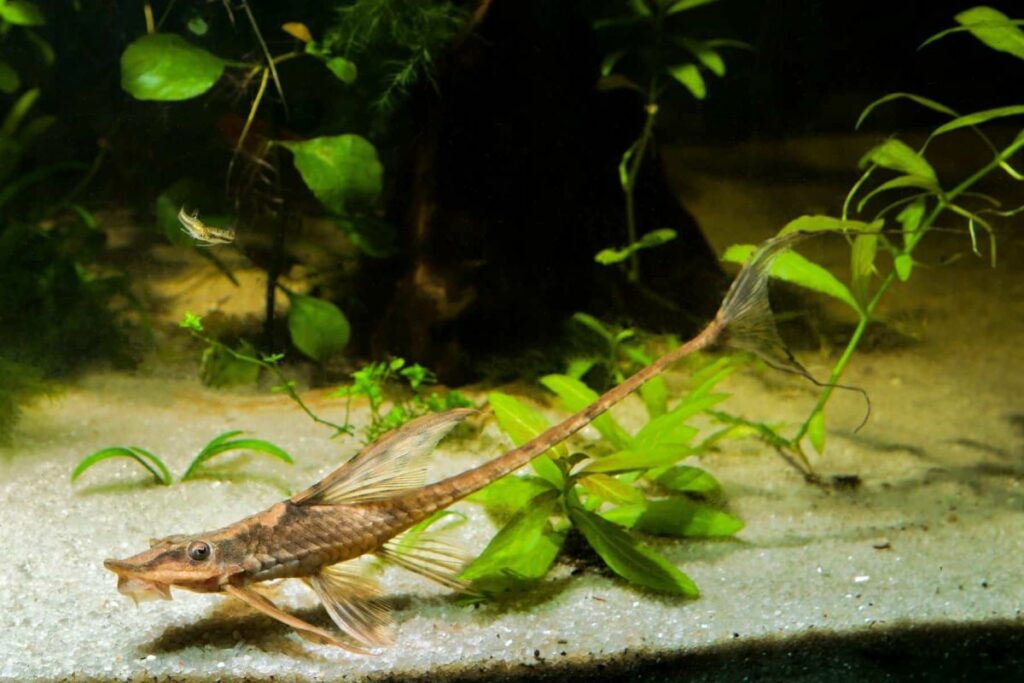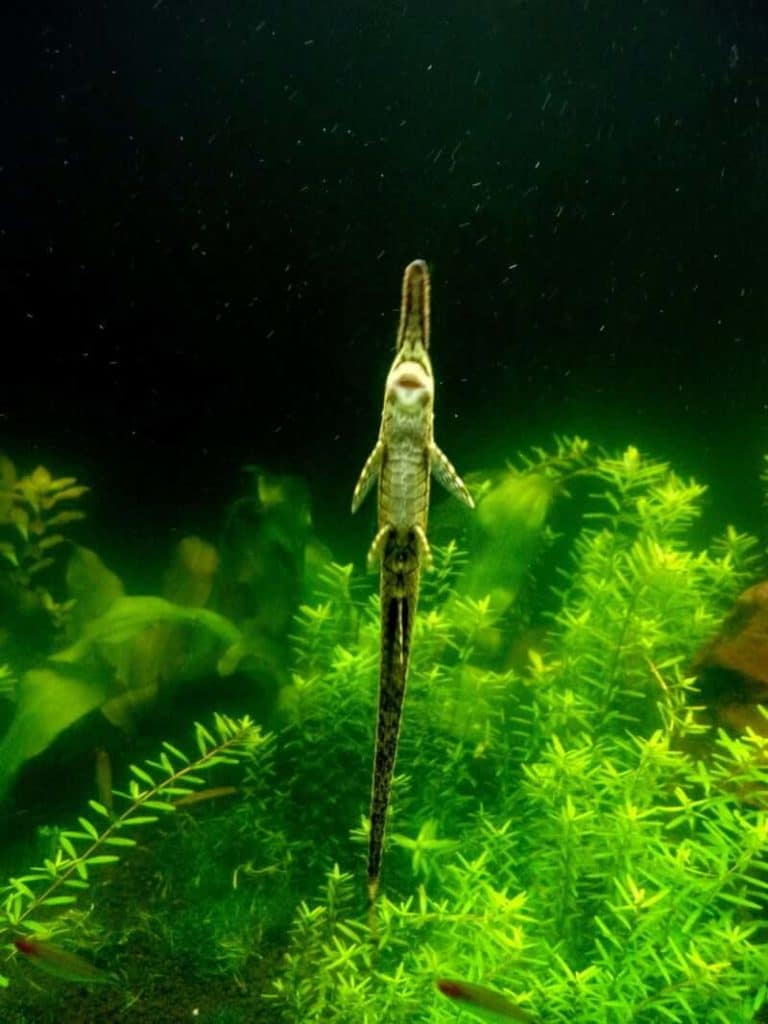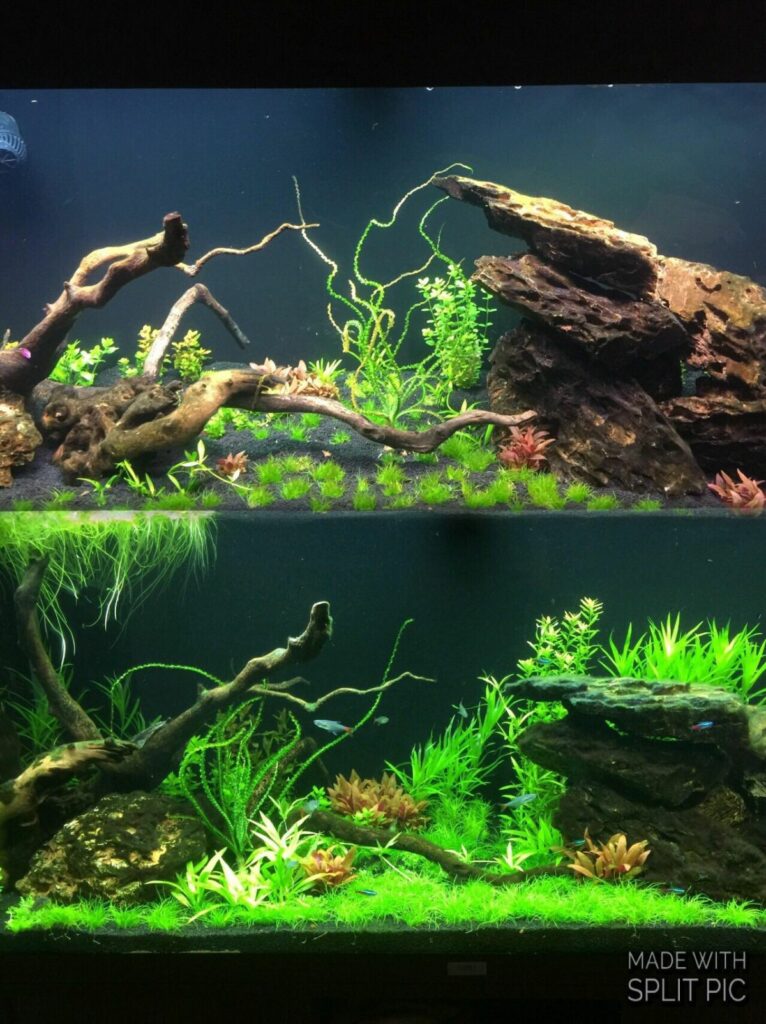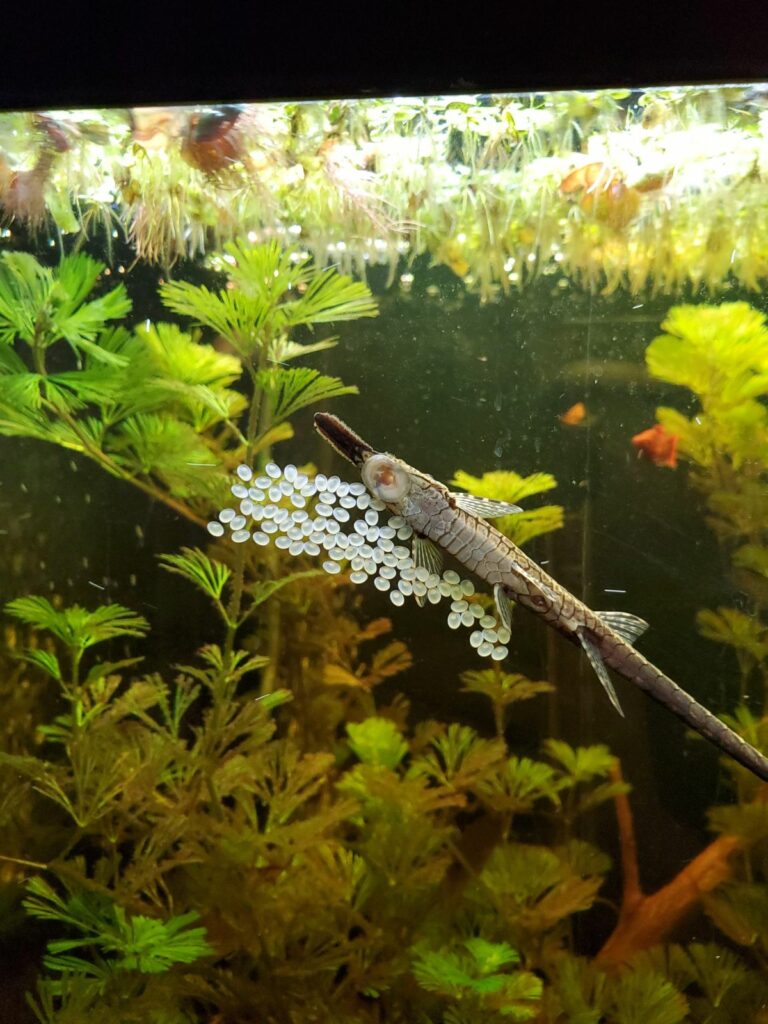Twig Catfish (also known as Farlowella catfish) are one of the most unusual freshwater fish in the aquarium trade. They look so exotic that you might be too intimidated to try keeping one.

That would be a mistake since as one of the best algae eating fish species twig catfish are a great addition to community tanks of small fish. They are a bit sensitive when it comes to water parameters and need to be fed with care, however. What else does it take to keep a twig catfish alive and healthy?
What are Twig Catfish?
The natural habitat of Twig Catfish is South America in the Amazon, Orinoco, and Parana River basins. There are several species in this group of freshwater fish. However Farlowella acus is the most common to find in aquarium stores.
As members of the family Loricariidae, Twig Catfish are suckermouth catfish. Their closest relatives are popular fish like Plecostomus, Dwarf Otocinclus, and Bristlenose Plecos.
Suckermouth catfish are all strange looking compared to other fish species but the Twig Catfish is even more unique. They have an elongated body meant to mimic twigs, submerged roots, and other river debris.
In their natural habitat in South America rivers flow through tropical rainforests. Tree debris falls into the water, allowing these unique fish to blend into the material and avoid predators.
Since they have a shy and peaceful nature you should design your home aquarium with care. This way a Twig Catfish does not feel always exposed, stressing it.
Twig Catfish are delicate algae eaters and very gentle when cleaning plant leaves of accumulated matter. This trait makes them a favorite for aquascapers since they help keep plants free of algae and looking their best. While they are vegetarian they won’t eat healthy plants.
- Common Names: Twig Catfish, Farlowella Catfish, Whiptail Catfish, Royal Farlowella Catfish
- Scientific Name: Farlowella sp. (Farlowella acus is the most common species)
- Origin: River basins in South America
- Length: 4 to 6 inches
- Aquarium Size: 20+ gallons
- Temperament: Peaceful; Shy
- Ease of Care: Moderate
Twig Catfish Care

Farlowella Twig Catfish need flat surfaces for grazing excess algae and breeding. As well as other fish that are peaceful and won’t harass them. Be sure you do a little homework on their water quality needs and habits. So long as you do, Twig Catfish are a good addition to planted aquariums.
Farlowella Catfish Tank Size
Twig Catfish size is moderate. An adult Farlowella Catfish will be between 4 and 6 inches, depending on the species. Therefore a 20 gallon fish tank is a minimum tank size for this species.
The Royal Farlowella Catfish (Sturisoma panamense) can grow up to 8 inches long at maximum size, and needs a larger tank than its cousins. An aquarium that is 40 gallons or larger is a suitable home for a Royal Whiptail Catfish.
Dim light and a dark substrate will help them feel even more at ease. Bright lighting and a lack of hiding places will cause them severe stress.
Water Conditions for Farlowella Catfish
The main reason why aquarists sometimes fail keeping Twig Catfish is due to their water quality needs. Remember, the majority of Farlowella fish are wild-caught. So they are more sensitive than captive bred fish to ammonia, nitrite, and nitrate.

These pollutants measure close to or at 0 parts per million in their home rivers. But in a home aquarium pollutants can build up without proper filtration or regular water changes.
Here is one reason why Twig Catfish thrive in aquariums full of live plants. Plants consume ammonia and other nitrogenous waste products as food. They also consume carbon dioxide, releasing oxygen in the process.
Plants also provide grazing places since algae likes to grow on the surface of leaves. If left unchecked this algae can compete with and harm your plants. Fortunately, Twig Catfish eat algae all the time, helping to keep your plants clean and healthy.
Choose plants that thrive in the warm water that Twig Catfish need. Discus aquarium plants will all do well in a Twig Catfish tank as they are all heat tolerant. As will most floating plants, including Red Root Floater and Duckweed.
Twig Catfish Water Chemistry
Your tank water quality should lean towards acidic for these freshwater fish. A pH below 7.0 is important for Twig Catfish health. They even thrive in blackwater aquarium conditions closer to pH 4.5, where decaying plant matter stains the water a dark tea color.
Aquarium driftwood does triple duty here in a Twig Catfish tank. It provides hiding places, a spot to graze on algae, and a source of tannins to keep the tank water acidic.
Another advantage to keeping Twig Catfish in a blackwater tank is that they will hide less. The dark water lowers light levels, helping the fish feel safer out in the open.
Any changes in water quality should be done carefully. If needed, gradually raising the pH or temperature is best. Sudden changes can result in death for these sensitive fish.
Last, the water temperature should remain on the warm side. 75 to 82°F is ideal for Twig Catfish Farlowella.
Twig Catfish Tank Mates
Choosing Twig Catfish tank mates can be a little challenging, given how shy and retiring they are. Don’t keep them with aggressive fish species.

Territorial cichlids and catfish need to be avoided. Twig Catfish are very sensitive to being bullied and will stress and die if harassed.
Always keep Twig Catfish in a community aquarium with other peaceful fish. Other South American fish are a good place to look. Here are a few fish that will live alongside a Farlowella catfish:
Feeding Twig Catfish
Long nosed catfish need a vegetarian diet to do well. There is no need to offer frozen foods or meaty foods since the excess protein is not necessary. Plant matter is what matters most; but what kind of plants?
Plant based pellets and algae waters are a good place to begin. If your Twig Catfish are too shy to eat during the day, add them at night when the lights are out. Farlowella Catfish have a quite slender body. But keep an eye on them to ensure they are not starving.
The slimy biofilm that grows on hard surfaces in an established fish tank is also a source of food for Farlowella Catfish. Planted aquariums tend to grow even more of this nutritious slime.
Sometimes it is hard to ensure your Twig Catfish get a varied diet. Besides algae and algae wafers you should offer items like blanched vegetables.
How to Breed Twig Catfish
Twig Catfish will breed in captivity. But they don’t lay many eggs at a time and need specific water conditions. Since breeding is a bit tricky the majority of fish tend to be wild caught.

If you want to breed your Farlowella Catfish then you should be careful to avoid subpar water quality. Tank conditions are the most important consideration for successful spawning. Warm, acidic conditions and an aquarium full of plants and driftwood are essential.
Male Twig Catfish can be sexed by examining the snout. They have a larger and broader snout compared to female fish. Otherwise their armored bodies look almost identical.
The eggs hatch after being laid on a flat surface. Driftwood, broad plant leaves (like Amazon Swords), or even the aquarium glass can host a clutch of Twig Catfish eggs.
Interested in learning more about breeding and caring for Twig Catfish fry? Here is an in-depth video on one fish keeper’s experience raising these fish:
Conclusion
Few fish look quite so strange as the Twig Catfish. But they are similar to Plecos and other suckermouth fish in terms of their feeding habits and care requirements. Just remember that they are quite shy so choose tank mates accordingly.
Also you need to create a fish tank that replicates their natural habitat (flooded areas full of plant life). By doing so, you will have success raising Twig Catfish and may even see them spawn for you.
More Frequently Asked Questions About Twig Catfish Care
Farlowella Catfish are a little more difficult to keep than other suckermouth fish. So here are some frequently asked questions about these freshwater fish to ease your journey with them.
Twig Catfish are all vegetarian, feeding on aquatic algae and biofilm. But you should supplement their diet with green vegetables and sinking herbivore pellets. You may need to feed them at night since Twig Catfish might not feel comfortable feeding with the lights on.
Twig Catfish eggs look like translucent ovals a few millimeters across. You will find a small cluster of them attached to a flat surface. The best places to look are on driftwood, rocks, flat plant leaves, or the aquarium glass.
Not at all. Twig Catfish are shy, sensitive aquarium fish. So you have to choose tank mates with care. Just add small, peaceful fish to a twig catfish tank. Other South American natives that enjoy warm, acidic water are best. Tetra fish, Discus, Angelfish, and Cory Catfish are a few species that will coexist with Twig Catfish.

